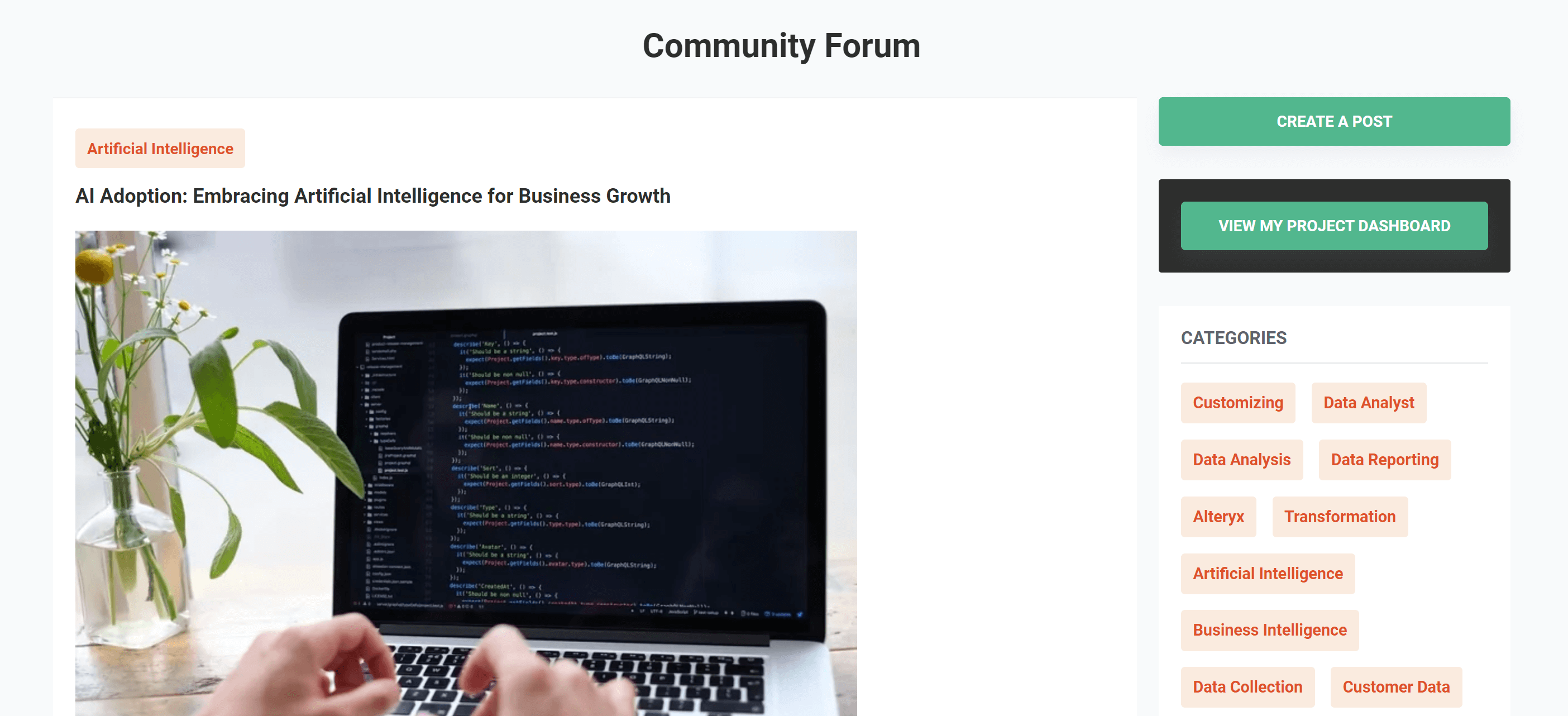The Future of Freelance Power BI: Trends & Predictions 2024 | Pangaeax

Table of content
Introduction to power bi
Overview of Power BI and Freelance Work
Importance of Data Analytics : The Future Of Business
Current Trends in Freelance Power BI Work
Surge in Predictive Modeling and Power BI Forecasting
An Augmented Future Driven by AI
Security and Governance Innovations
Power BI Forecasting: A New Era
Increasing Demand for Data Visualization
Specialized Skill Sets in Power BI
The Revolutionary Impact of Data Analytics and Automation
Predictions for the Future of Freelance Power BI Work
Conclusion
Introduction to power bi
Power BI is a comprehensive suite of software services, apps, and connectors designed to transform disparate data sources into coherent, visually immersive, and interactive insights. Whether your data is stored in an Excel spreadsheet or across cloud-based and on-premises hybrid data warehouses, Power BI allows seamless connection to these sources. It enables users to visualize and discover critical information, which can then be shared with anyone.
As a technology-driven business intelligence tool from Microsoft, Power BI is essential for data analysts to analyze and visualize raw data, turning it into actionable insights. It merges business analytics, data visualization, and industry best practices to help organizations make informed, data-driven decisions. In recognition of its capabilities, Gartner named Microsoft a Leader in the “2019 Gartner Magic Quadrant for Analytics and Business Intelligence Platform.”
Overview of Power BI and Freelance Work
Power BI, a powerful business analytics tool by Microsoft, enables users to transform raw data into actionable insights through interactive dashboards and reports. Its user-friendly interface and robust data visualization capabilities make it popular among data professionals and organizations seeking to enhance their decision-making processes.
Power BI freelance work has gained traction as businesses increasingly require customized reports and data-driven solutions tailored to their specific needs. Freelancers specializing in Power BI often leverage their skills in Data Analysis Expressions (DAX) to build sophisticated data models and visualizations.
These professionals work across various industries, including finance, healthcare, and retail, helping clients harness their data effectively. As remote work becomes more prevalent, the demand for Power BI freelance work is rising, offering lucrative opportunities for those adept in data visualization and analytics.
Importance of Data Analytics : The Future Of Business
The importance of data analytics is rapidly growing as it becomes a cornerstone of modern business strategy. By harnessing data analytics, businesses can uncover valuable insights, identify trends, and predict future outcomes, driving informed decision-making and innovation.
This capability is crucial for staying competitive in a fast-paced market, enabling companies to optimize operations and personalize customer experiences. Advanced data analytics tools help businesses improve efficiency, reduce costs, and enhance profitability by providing a deeper understanding of market dynamics and consumer behaviour.
As technology evolves, the integration of artificial intelligence and machine learning into data analytics promises even greater predictive power and automation. For businesses looking at the future of business, leveraging data analytics is not just an option but a necessity, ensuring they stay ahead of competitors and adapt to the ever-changing demands of the market.
Current Trends in Freelance Power BI Work
In the dynamic realm of business intelligence (BI), Power BI has become a key player, transforming the way organizations visualize and analyze data. As we move into 2024, it’s essential to examine the emerging trends and capabilities within Power BI that are defining the future of self-service BI and advanced analytics.
This blog will explore the potential of augmented and predictive analytics through Power BI. We’ll investigate how features like machine learning, forecasting, and natural language processing, along with the latest Power BI updates, are making data analysis and reporting more autonomous and accessible for organizations.
Power BI’s remarkable growth and ongoing improvements suggest that this year will see significant strides in predictive analytics, AI integration, and enhanced data connectivity. These advancements are poised to become more accessible and integral to business strategies. Here are some of the key Power BI trends and developments to watch for in 2024:
Surge in Predictive Modeling and Power BI Forecasting
One of the major Power BI trends for 2024 is Microsoft’s push to broaden access to predictive modeling for everyday business users. This effort will likely be supported by assisted machine learning, which simplifies creating and deploying predictive models. Expect automated model suggestions and evaluations to play a central role, helping users easily choose and implement the best models for their data.
This shift towards more democratized predictive modeling is set to enhance the adoption of Power BI forecasting and predictive analytics across various industries. Teams will be better equipped to use data for forward-looking forecasts, improving decision-making and strategic planning. With improved accuracy in predicting market trends, customer behaviors, and business outcomes, many organizations will find these tools transformative.
An Augmented Future Driven by AI
AI and machine learning are set to continue their deep integration into Power BI, aligning with the platform’s vision for the future of BI. We can anticipate advancements in natural language BI, where users will interact with data using conversational language, making analysis more accessible to a wider audience.
Automated insights are another area where AI’s influence will be significant. The latest Power BI updates are expected to make self-service data analysis highly autonomous, freeing users to focus on more complex tasks. By allowing AI to handle routine reporting and analysis, users will have more time to extract actionable insights from their data.
Security and Governance Innovations
As data infrastructure becomes increasingly complex, Microsoft is expected to enhance Power BI with robust security and governance updates. Innovations in access management, compliance, and data protection will be essential to meet modern security challenges.
Features like sensitivity labeling and multi-factor authentication are likely to be prominent in these updates, adding layers of protection to ensure data security and regulatory compliance. As organizations become more data-driven, the importance of these security and governance enhancements cannot be overstated, ensuring Power BI remains a reliable platform for business intelligence.
Power BI Forecasting: A New Era
Looking ahead to 2024, Power BI forecasting is set to enter a new era of sophistication and precision. With the integration of advanced machine learning algorithms, forecasting in Power BI is expected to become a key feature for businesses aiming to excel in planning and strategy.
The latest updates are likely to include improved time series analytics, allowing for more accurate and nuanced forecasting models. This means businesses will not only gain insights into current data trends but also predict future patterns and market dynamics with greater accuracy. For industries where staying ahead of the curve is crucial, the enhanced forecasting capabilities in Power BI will be a game-changer.
Increasing Demand for Data Visualization
Data visualization is transforming how organizations make decisions by providing clear, intuitive representations of complex data. Here are some key factors contributing to the increasing demand for data visualization:
1. Rising Need for Interactive Data Representation
In today’s fast-paced world, industries are increasingly relying on interactive data visualizations to enhance their data presentations. Tools like graphs, charts, and tables simplify complex information, making it easier to understand and act upon. The integration of cloud computing further supports this trend, offering flexibility in managing and scaling large datasets. This combination of rapid decision-making and cloud-based solutions is fueling the growing market for data visualization.
2. Businesses Striving to Maintain a Competitive Edge
Data visualization is crucial for businesses aiming to stay ahead of the competition. By developing new strategies and making informed decisions, companies can navigate their markets more effectively. For instance, leading e-commerce platforms handle vast amounts of operational data daily, optimizing supply chains and delivery plans. Service industries, such as hospitality and airlines, leverage data visualization to refine business models, analyze competition, compare pricing and availability, and craft targeted marketing campaigns.
3. Explosion of Data Volume
The surge in digital technology and internet usage has led to an unprecedented increase in data generation. Organizations now need powerful tools and techniques to sift through this vast sea of information and extract meaningful insights. Data visualization tools are essential for making sense of large datasets and turning them into actionable knowledge.
4. Technological Advancements
Advances in technology have made it easier and more cost-effective for organizations to create and share data visualizations. New and improved tools allow for more sophisticated visual representations, helping businesses present their data in compelling and accessible ways.
5. Enhanced Communication of Data Insights
Data visualization enables users to explore and manipulate data through various visual formats, offering a more intuitive approach than traditional methods. This capability allows organizations to present insights to a broader audience, including management and non-technical stakeholders, facilitating better-informed business decisions.
6. Gaining a Deeper Understanding of Customers
Businesses use data visualization to gain insights into customer behavior, preferences, and needs. By analyzing these visual representations, companies can better understand their customers and tailor their strategies to meet their expectations.
Specialized Skill Sets in Power BI
Data Modeling
Data modeling is crucial for any Power BI developer. It involves creating conceptual, logical, and physical data models. The conceptual model outlines high-level entities and their relationships. The logical model details these entities and relationships further. The physical model represents the database schema. Power BI developers need to master these skills to enable data aggregation, filtering, and sorting.
Learn DAX
DAX (Data Analysis Expressions) is a language used in Power BI to create calculated columns, measures, and tables. It allows developers to perform complex calculations and data manipulations.
Data Analytics
Data analytics involves transforming raw data into valuable insights essential for business growth. Power BI developers need to explore various data analysis techniques to create data-driven strategies.
Data Visualization
Data visualization makes data understandable and engaging. Power BI enables the creation of live dashboards, interactive reports, charts, and graphs, helping users gain powerful business insights.
SQL
SQL is essential for data manipulation. A solid understanding of SQL is necessary for using Power BI efficiently. Online courses can help in learning SQL.
Data Warehouse
A data warehouse integrates data from various sources and is crucial for generating insights and trends. It supports data analytics using Power BI tools.
Building Data Visualizations and Reports
Power BI allows the creation of easy-to-understand and visually appealing reports and dashboards without complex features.
Business Intelligence
Business intelligence involves deriving meaning from data to identify profitable opportunities. Power BI supports data analysis and trend forecasting.
Power BI Fundamentals
A strong grasp of Power BI’s main features, functionality, and best practices for data modeling, transformation, and presentation is essential.
Analytical Language
Data experts should apply statistical methods and analytical skills accurately, using appropriate terminology and concepts.
Create Paginated Reports
Power BI’s pagination functionality allows the creation of high-resolution reports suitable for sharing with stakeholders.
Data Integration
Data integration skills focus on creating reports that seamlessly combine data from multiple sources.
Excel
Proficiency in Excel is vital for importing data into Power BI and conducting detailed analyses alongside Power BI reports.
Learn Python
Python enhances data management and analysis capabilities. It offers libraries for data manipulation, statistical analysis, and machine learning. Python scripts can be embedded in Power BI for automation and personalization of the data analysis process.
The Revolutionary Impact of Data Analytics and Automation
In the age of technological transformation, automation and data analytics are revolutionizing industries and reshaping the nature of work. The global volume of data is projected to surge from 64 zettabytes in 2020 to 180 zettabytes by 2025, highlighting the growing importance of data analytics automation. This automation enhances decision-making processes, operational efficiencies, and the detection of risks and vulnerabilities across sectors.
Efficiency and Productivity:
Automating routine tasks saves time and reduces errors, while predictive analytics, powered by AI and machine learning, provides insights into future trends, enabling proactive strategies.
Challenges and Opportunities:
Despite the promise of cost optimization and reduced bias from diverse data sources, challenges like data security and the potential loss of human judgment remain. The high demand for skilled data analysts underscores the need for accuracy, transparency, and strategic decision-making in automated processes.
Integrating AI into automation and data analytics enhances existing systems and introduces new possibilities. However, maintaining a balance between leveraging automated technology and preserving essential human oversight is crucial. By investing in the right technologies, upskilling the workforce, and staying abreast of emerging trends, companies can navigate this evolving landscape and prepare for a future where analytics, automation, and AI are central to business strategy and operations.
Emerging Trends and Predictions for AI and Automation
Looking ahead, several emerging trends and predictions highlight the transformative potential of AI and automation across various sectors.
Manufacturing and Analytics:
- Data Analytics Platforms: These platforms are revolutionizing manufacturing by offering insights that drive smarter, more efficient operations.
- Edge Analytics: Real-time optimizations reduce resource waste and enhance decision-making accuracy, fostering more creative and intuitive choices.
Healthcare and Ethical Considerations:
- Advancements: AI’s progress in language and image processing significantly benefits healthcare and brain sciences.
- Challenges: Automated decision-making poses risks of misinformation, discrimination, and bias.
- Solutions: Ensuring continuous communication and engagement between humans and automated systems is vital to mitigating negative impacts.
Creative and Generative AI:
- Innovations: AI’s capability to generate original content creates new opportunities in art, music, and literature, raising ethical questions about creativity and ownership.
- Applications: AI is poised to revolutionize business processes, healthcare, education, and even address climate change through predictive analytics.
These trends emphasize the need for a balanced approach to AI and automation, where technological advancements are harmonized with ethical considerations and human oversight. This approach ensures that the benefits are shared equitably and responsibly across society.
Predictions for the Future of Freelance Power BI Work
The future of freelance Power BI work is looking very bright as data-driven decision-making becomes more critical than ever.
With businesses increasingly needing tailored data solutions and interactive dashboards, the demand for freelance Power BI experts is set to rise. The continuous advancements in data analytics and AI integration will expand Power BI’s capabilities, allowing freelancers to provide even deeper and more sophisticated insights.
Remote work trends are also playing a significant role in expanding opportunities for freelancers, as they can now serve clients from around the world. As data becomes more complex, organizations will increasingly rely on skilled Power BI professionals to help them navigate and make the most of their data.
In the past month, one notable platform making it easier for clients and freelancers to connect for Power BI and data analysis projects is PangaeaX. This platform simplifies the process of finding and engaging with top freelance talent in the Power BI space, further boosting opportunities for professionals and meeting the growing demand for expert data solutions.
Conclusion :
As we advance into 2024, the landscape of Power BI and freelance data analytics is evolving rapidly. Power BI’s robust capabilities continue to empower businesses to transform raw data into actionable insights, while the growing demand for freelance experts highlights the increasing importance of tailored data solutions. With emerging trends in predictive analytics, AI integration, and enhanced data visualization, freelancers are well-positioned to leverage these advancements and offer valuable insights to organizations worldwide. Embracing these changes and utilizing platforms like PangaeaX can significantly enhance opportunities for professionals in the Power BI space, driving innovation and strategic decision-making across industries.
Get your data results fast and accelerate your business performance with the insights you need today.



